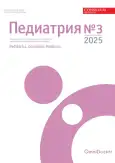3-M syndrome: endocrinologist's view of a rare genetic disease. Case report
- Authors: Volevodz N.N.1,2, Zyuzikova Z.S.1
-
Affiliations:
- National Medical Research Center for Endocrinology
- Vladimirsky Moscow Regional Research Clinical Institute
- Issue: No 3 (2025)
- Pages: 306-310
- Section: Articles
- URL: https://pediatria.orscience.ru/2658-6630/article/view/677129
- DOI: https://doi.org/10.26442/26586630.2025.3.203396
- ID: 677129
Cite item
Full Text
Abstract
3-M syndrome is a rare hereditary disease with an autosomal recessive type of inheritance, characterized by intrauterine and severe postnatal growth retardation, phenotypic and radiological features with no intellectual disability. A little more than 200 cases of this syndrome have been described in the world. 3-M syndrome is the only disease to date that is associated with pathogenic biallelic variants in the genes CCDC8, CUL7, OBSL1. Short stature is the main clinical manifestation of 3-M syndrome. Until now, the issue of treating short stature with growth hormone remains controversial due to the small number of patients with this disease and the lack of large-scale clinical studies.
Keywords
Full Text
About the authors
Natalia N. Volevodz
National Medical Research Center for Endocrinology; Vladimirsky Moscow Regional Research Clinical Institute
Email: zyuzikova.zinaida@endocrincentr.ru
ORCID iD: 0000-0001-6470-6318
SPIN-code: 1127-0933
D. Sci. (Med.), Prof.
Russian Federation, Moscow; MoscowZinaida S. Zyuzikova
National Medical Research Center for Endocrinology
Author for correspondence.
Email: zyuzikova.zinaida@endocrincentr.ru
ORCID iD: 0000-0001-6709-8231
SPIN-code: 6731-8990
Cand. Sci. (Med.)
Russian Federation, MoscowReferences
- Xu N, Liu K, Yang Y, et al. Chinese patients with 3M syndrome: clinical manifestations and two novel pathogenic variants. Front Genet. 2023;14:1164936. DOI:120.3389/fgene.2023.1164936
- Miller JD, McKusick VA, Malvaux P, et al. The 3-M syndrome: a heritable low birthweight dwarfism. Birth Defects Orig Art Ser. 1975;XI(5):39-47.
- Maksimova N, Hara K, Miyashia A, et al. Clinical, molecular and histopathological features of short stature syndrome with novel CUL7 mutation in Yakuts: new population isolate in Asia. J Med Genet. 2007;44(12):772-8. doi: 10.1136/jmg.2007.051979
- Guo L, Feng Z, Jin, X, et al. A novel mutation within intron 17 of the CUL7 gene results in appearance of premature termination codon. Clin Chim Acta. 2020;507:23-30. doi: 10.1016/j.cca.2020.04.008
- Huber C, Delezoide A, Guimiot F, et al. A large-scale mutation search reveals genetic heterogeneity in 3M syndrome. Eur J Hum Genet. 2019;17:395-400. doi: 10.1038/ejhg.2008.200
- Simsek-Kiper PO, Taskiran E, Kosukcu C, et al. Further expanding the mutational spectrum and investigation of genotype-phenotype correlation in 3M syndrome. Am J Med Genet. 2019;179A:1157-72. doi: 10.1002/ajmg.a.61154
- Khachnaoui-Zaafrane K, Ouertani I, Zanati A, et al. 3M syndrome: a Tunisian seven-cases series. Eur J Med Genet. 2022;65:104448. doi: 10.1016/j.ejmg.2022.104448
- van der Wal G, Otten BJ, Brunner HG, et al. 3-M syndrome: description of six new patients with review of the literature. Clin Dysmorphol. 2001;10(4):241-52. doi: 10.1097/00019605-200110000-00002
- Hanson D, Murray PG, Sudand A, et al. The primordial growth disorder 3-M syndrome connects ubiquitination to the cytoskeletal adaptor OBSL1. Am J Hum Genet. 2009;84:801-6. doi: 10.1016/j.ajhg.2009.04.021
- Волеводз Н.Н., Воронцова М.В., Кокорева В.Д., и др. Синдром Сильвера–Рассела: клиника, диагностика, лечение: учебно-методическое пособие. М.: Наука, 2024 [Volevodz NN, Vorontsova MV, Kokoreva VD, et al. Sindrom Silvera–Rassela: klinika, diagnostika, lechenie: uchebno-metodicheskoe posobie. Moscow: Nauka, 2024 (in Russian)].
- Irving M, Holder-Espinasse M. Three M Syndrome. 2002. In: Adam MP, Feldman J, Mirzaa GM, et al. GeneReviews®. Seattle (WA): University of Washington, Seattle, 1993-2025.
- Tatiya N, Kesri R, Ukey A. Seckel Dwarfism – A Rare Autosomal Recessive Inherited Syndrome: A Case Report. Int J Clin Pediatr Dent. 2024;17(2):211-5. doi: 10.5005/jp-journals-10005-2765
- Mudassir BU, Agha Z. Microcephaly, Short Stature, Intellectual Disability, Speech Absence and Cataract Are Associated with Novel Bi-Allelic Missense Variant in RTTN Gene: A Seckel Syndrome Case Report. Children (Basel). 2023;10(6):1027. doi: 10.3390/children10061027
Supplementary files









